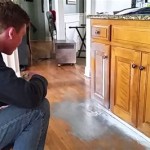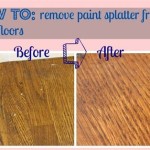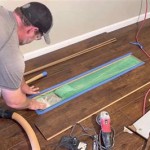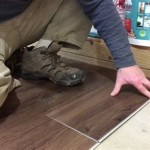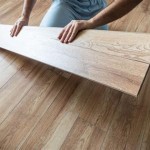How To Level Subfloor For Tile: A Comprehensive Guide
Installing tile flooring can significantly enhance the aesthetic appeal and functionality of any space. However, the success of a tile installation hinges heavily on the quality and condition of the subfloor. An uneven subfloor can lead to cracked tiles, grout failure, and an overall unsatisfactory finished product. Therefore, properly leveling the subfloor is a critical step that should not be overlooked. This article provides a detailed guide on how to level a subfloor in preparation for tile installation.
The primary goal of leveling a subfloor is to create a perfectly flat and stable surface. This flatness ensures that the tile adhesive, or mortar, can be applied evenly, preventing voids and weak spots beneath the tiles. A stable subfloor prevents movement that could cause the tiles to crack or become detached over time. Several methods exist for leveling a subfloor, each suited to different types of subfloor materials and the severity of the unevenness. These methods include self-leveling underlayment, patching compounds, and shimming techniques.
Before commencing any leveling work, a thorough assessment of the subfloor is necessary. This assessment will determine the type of leveling method required and the materials needed. Identifying the low and high spots, as well as any structural issues, is crucial for a successful outcome.
Identifying Subfloor Issues and Assessing Levelness
The first step in leveling a subfloor is to identify any existing problems that need to be addressed. This involves a careful inspection of the subfloor material for signs of damage, such as water stains, rot, or insect infestation. Any damaged sections must be repaired or replaced before proceeding with the leveling process. Additionally, one should check for loose or squeaky sections of the subfloor, which can indicate underlying structural issues that need to be resolved. Addressing these issues early on will prevent future problems and ensure the longevity of the tile installation.
Assessing the levelness of the subfloor requires the use of appropriate tools. A long spirit level (at least 6 feet in length) or a laser level is recommended for this task. The spirit level should be placed on the subfloor in various directions, noting any gaps or deviations from level. A laser level projects a horizontal or vertical line, which can be used as a reference point to identify high and low spots more accurately. Measure the depth of any low spots and the height of any high spots to determine the extent of the unevenness. This information will be essential for selecting the appropriate leveling method.
For larger areas, a chalk line can be used in conjunction with a level to create a grid on the subfloor. This grid will visually represent the areas that need to be leveled, making it easier to apply leveling compounds or shims accurately. The grid lines should be spaced according to the manufacturer's instructions for the leveling compound being used. By creating a visual representation of the unevenness, one can ensure that all areas are addressed effectively.
Preparing the Subfloor for Leveling
Proper preparation is essential for the successful application of any leveling method. This includes cleaning the subfloor thoroughly to remove any dirt, dust, debris, and old adhesive residue. A shop vacuum is highly effective for this purpose. Ensure that all surfaces are free of any contaminants that could interfere with the adhesion of the leveling compound or shims. If necessary, use a scraper to remove stubborn adhesive residue.
After cleaning, the subfloor should be primed with a suitable primer. The type of primer will depend on the subfloor material and the leveling compound being used. Priming enhances the adhesion of the leveling compound and prevents it from drying out too quickly. Follow the manufacturer's instructions for the application of the primer, ensuring that it is applied evenly and allowed to dry completely before proceeding with the leveling process. A properly primed subfloor will provide a strong and stable base for the tile installation.
For wood subfloors, it may be necessary to reinforce any weak or unstable sections before leveling. This can involve adding additional screws or nails to secure the subfloor to the joists. Any large gaps or cracks should be filled with wood filler or patching compound. For concrete subfloors, any cracks or holes should be repaired with a concrete patching compound. Addressing these issues will prevent the leveling compound from settling into the gaps or cracks, ensuring a smooth and level surface.
Applying Leveling Methods: Self-Leveling Underlayment and Patching Compounds
Self-leveling underlayment (SLU) is a cement-based product that is designed to flow and level itself across a surface. It is suitable for leveling large areas with significant unevenness. The application of SLU requires careful preparation and adherence to the manufacturer's instructions. The first step is to create a dam around the perimeter of the area to be leveled. This can be done using foam strips, duct tape, or other suitable materials. The dam will prevent the SLU from flowing out of the designated area.
Next, the SLU should be mixed according to the manufacturer's instructions. It is important to use the correct amount of water and to mix the product thoroughly to ensure a smooth and consistent consistency. The mixed SLU should be poured onto the subfloor and allowed to flow and level itself. A gauge rake can be used to help distribute the SLU evenly. The SLU should be allowed to dry completely before proceeding with the tile installation. The drying time will vary depending on the product and the ambient conditions.
Patching compounds are suitable for leveling small areas or filling in localized imperfections. These compounds are typically cement-based or epoxy-based and can be applied with a trowel or putty knife. The patching compound should be applied to the low spots or imperfections, feathering the edges to blend seamlessly with the surrounding surface. Multiple layers may be necessary to achieve the desired levelness. Allow each layer to dry completely before applying the next. Once the patching compound is dry, it should be sanded smooth to create a uniform surface.
When using patching compounds, it is important to select a product that is compatible with the subfloor material and the tile adhesive being used. Some patching compounds are specifically designed for wood subfloors, while others are formulated for concrete subfloors. Additionally, some tile adhesives require the use of a specific type of patching compound. Choosing the correct product will ensure a strong and durable bond between the subfloor, the patching compound, and the tile.
For larger areas with minor unevenness, a combination of patching compounds and self-leveling underlayment may be used. The patching compound can be used to fill in larger low spots, while the self-leveling underlayment can be used to create a smooth and level surface across the entire area. This approach can be more cost-effective than using self-leveling underlayment exclusively.
Safety precautions should be observed when working with leveling compounds and patching compounds. Wear appropriate personal protective equipment, such as gloves, eye protection, and a dust mask. Ensure adequate ventilation in the work area. Follow the manufacturer's instructions for the safe handling and disposal of the products.
After the leveling compound or patching compound has dried completely, the subfloor should be inspected again to ensure that it is level. Use a spirit level or laser level to check for any remaining unevenness. If necessary, additional layers of leveling compound or patching compound can be applied to correct any imperfections. Once the subfloor is perfectly level, it is ready for the tile installation.
In summary, leveling a subfloor for tile installation requires careful planning, preparation, and execution. Addressing any existing problems, assessing the levelness of the subfloor, preparing the surface properly, and applying the appropriate leveling method are all essential steps. By following these guidelines, one can ensure a successful tile installation that will provide years of enjoyment.

How To Prepare A Subfloor For Tile Installation The Home

How To Prepare A Subfloor For Tile Installation The Home

How To Level A Subfloor Before Laying Tile

How To Prepare A Subfloor For Tile Installation The Home

How To Level A Floor For Tile Expert Tips And Advice

How To Prepare A Subfloor For Tile Installation The Home

How To Prepare Subfloor For Tile The Home
%20(2).png?strip=all)
How To Level A Subfloor Lay Flooring

Learn How To Level A Floor For Tile Rubi Blog Usa

Tile Underlayment The Complete Guide For Beginners Diytileguy
See Also

